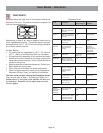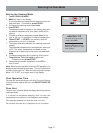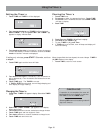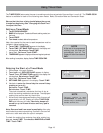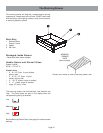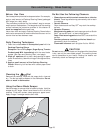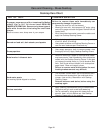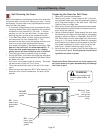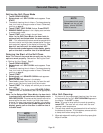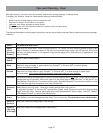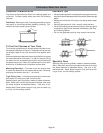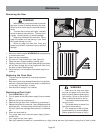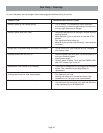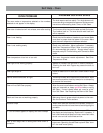
Page 24
Care and Cleaning - Glass Cooktop
Cooktop Care Chart
TYPE OF SOIL
Failure to remove these soils immediately can
permanently damage the surface.
• Remove pan and turn off the element.
• Wearing an oven mitt, hold scraper at 30
o
angle, using
care not to gouge or scratch the glass. Push soil off the
heated area.
• After the surface has cooled, remove the residue and
apply the Cooktop Cleaning Creme.
• Soften by laying a damp paper towel or sponge on top
of soil for about 30 minutes.
• Use a plastic scrubber and Cooktop Cleaning Creme
or
use the razor blade scraper. Rinse and dry.
• Use a soapy sponge or cloth to remove grease; rinse
thoroughly and dry. Apply Cooktop Cleaning Creme.
• Pans with aluminum, copper or stainless steel bases
may leave marks. Treat immediately, after surface has
cooled, with the Cooktop Cleaning Creme. If this does
not remove the metal marks, try a mild abrasive (Bon
Ami
®
, Soft Scrub
®
without bleach) with a dampened
paper towel. Rinse and reapply creme.
Failure to remove metal marks before the next
heating makes removal very difficult.
• The minerals in some water can be transferred onto
the surface and cause stains. Use undiluted white
vinegar, rinse and dry. Recondition with Cooktop
Cleaning Creme.
Remove boilovers and stains, before using the
cooktop again.
• Apply Cleaning Creme before using to remove sand-
like grains and grit such as salt and seasoning.
• Can be reduced by using pans with bases that are
smooth, clean, and dry before use. Use Cooktop
Cleaning Creme daily on the cooktop.
POSSIBLE SOLUTION
Dry sugar, sugar syrup, milk or tomato spills. Melted
plastic film or foil. All these items REQUIRE
IMMEDIATE REMOVAL. Remove only these types of
spills while the surface is hot using the razor blade
scraper.
Be sure to use a new, sharp razor in your scraper.
Burned-on food soil, dark streaks, and specks
Greasy spatters
Metal marks: Iridescent stain
Hard water spots
Hot cooking liquids dripped on surface
Surface scratches



